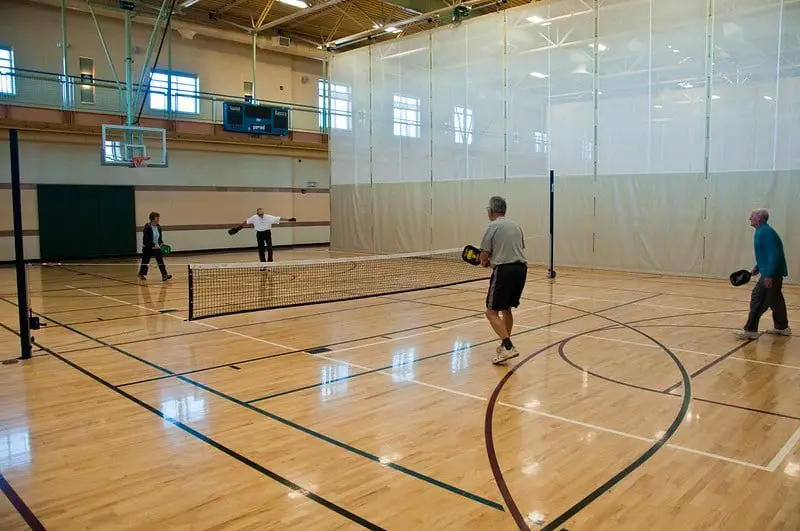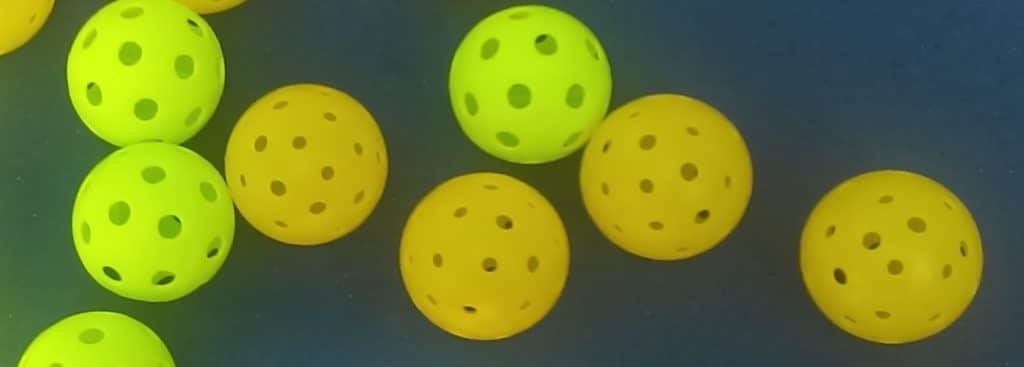Pickleball is one of the few sports – if not the only sport – I know of that have different balls that are best suited for whether you are playing indoors or outdoors.

There are a lot of choices when it comes to balls for both indoor and outdoor – but at least you only need one type of racket whether you’re playing indoors or outdoors!
For specific ball recommendations, check out my Best Pickleball Balls for Indoor and Outdoor ball recommendations.
(Check out our pickleball paddle recommendations: Best Pickleball Paddles for Beginners And Paddle Buying Guide and Top Rated Pickleball Paddles of 2020)
What kind of ball is used in Pickleball?
Pickleball is played with plastic balls that are reminiscent of whiffle balls with a number of holes in them and with different types of indoor vs outdoor pickleballs that are best suited for where you are playing.
The official rules from the USAPA allow for a range of specifications which allow for tweaks to different types of balls for indoor play vs outdoor play. There is wiggle room in terms of the size, weight, bounce, hardness, and number of holes.
While you obviously won’t get arrested for playing with the “wrong” type of ball, why not play with the best ball for the type of court you’re on?
Pickleball ball colors are all over the map so you can get just about any color (or multi-color) ball you want — but read until the end of this article to find out why even the ball color matters. They are usually made to be a bright color so that they are easy to see: yellow, orange and bright green are probably the most common color balls.

So getting to it: what’s the difference between indoor and outdoor pickleballs?
Outdoor pickleball ball characteristics
- Made from harder, smoother plastic to help make them last longer in the elements
- Heavier and less affected by wind
- Have smaller, more numerous holes – usually about 40
- Allow for harder hitting and faster shots – though with less control
- Generally lead to shorter rallies
- Bounce higher
- Will be harder in the cold, softer in the heat
- Make more noise
- Weighs about 0.9 ounces
- Need to be replaced more often than indoor balls due to exposure to the elements and bouncing off of rougher outdoor surfaces
- Onix, Top and Dura brand balls are the most popular
- According to Pickleball Central, yellow is the most popular with white and orange being runners up It’s key to have a brightly colored ball that is easy to see in a variety of outdoor light conditions.
Indoor pickleball balls characteristics
- Tailored for smoother indoor court surfaces and the still air of indoor play
- Are made from softer plastic
- Lighter
- Have larger, fewer holes – usually about 26
- Don’t bounce as high
- Allow for more control in your serve – though with less power, that can lead to longer rallies than a more hard-hitting outdoor game
- Weighs about 0.8 ounces
- Wears out by going soft, versus going out of round or cracking
- Hurt less if you get hit by one!
If you’re brand new to the game, you will benefit from buying a variety pack and trying out different styles of balls in different contexts. (Or if you’re super brand new you might just want to get a Pickleball Set.) And keep in mind that depending on the ball, it might take a bit of playing with a brand new ball before it gets to its ideal condition.
Looking to improve your game?
Check out this excellent pickleball video training course from High Performance Pickleball Academy. (Affiliate link) They break down the game into 8 key skills and instruct you on how to master them.
You also shouldn’t feel too worried about being stuck with any particular ball because depending on how hard you are playing and the type of ball, balls can become unplayable after just a couple of games.
So why not buy a handful of different brands of balls to try them out?
Although it’s less common, you might be the type who prefers one type of ball over another regardless of whether you are indoors or outdoors. If you want more control and longer rallies, go with indoor; if you are more interested in harder hitting and less concerned about control, go with outdoor.
Beware, though: if you’re playing indoors on a wood surface, outdoor balls may skid around so you are will have better luck going with an indoor ball on wood surfaces.
How can you tell the difference between an indoor and an outdoor pickleball?
You can usually tell by looking at them: biggest giveaway is that the indoor pickleballs have larger holes while the outdoor pickleballs have smaller holes.
The number of holes can also be an indicator – the range of holes on a ball can be between 26 and 40 – indoor balls will tend towards the lower end of that scale with outdoor balls tending towards the upper.
One thing to note if you want to start competing: the most common ball used in competition is the Dura Fast 40 outdoor ball. (And this ball actually has 2 different sized holes.) If you want to compete, start practicing with that type of ball to get the closest tournament experience possible and buy a lot if you are going to get a pickleball machine.
Be aware: there are, as of this writing, 33 pickleball brands that are approved by the USAPA/IFP for tournaments. This is a list of both indoor and outdoor pickleballs that have been tested out and deemed appropriate for officially sanctioned play. To be absolutely sure if you’re practicing with the right pickleball, check with your specific tournament to find out what they will be playing with.
If you’re not playing in a tournament any time soon, go nuts and buy whatever ball you want!
Do pickleballs wear out? How long do balls last?
Similar to tennis balls (though for different reasons), pickleballs wear out! Despite being made of pretty durable plastic, balls do crack and wear down, so it’s best to have a few on hand as backups.
This is almost impossible to answer. It depends on the brand of ball, the weather conditions, and how hard the ball is being hit. A ball might not even last an entire game or it might last you a number of games! Really can’t give a good answer here.
Suffice to say you should ALWAYS have some backup balls regardless of whether you are playing outside or inside. You never know when a ball might go out of round or crack.
Even though outdoor pickleballs are more durable they do need to be replaced more often since they will degrade from sun exposure and more unforgiving surfaces. If you’re playing hard on a rough outdoor court, an outdoor ball might only last a few games since it might crack or go out of round, which means it isn’t perfectly circular anymore. When it is out of round it won’t fly in as consistent a manner as it did when it was new.
Temperature can also play a factor: the colder it is the more likely it is for an outdoor ball to crack.
You can test if a ball is out of round by hitting it straight up in the air (when your racket is parallel to the ground) with a bit of spin on it. If it veers off course on it’s way down, assuming there is no wind, the ball is likely out of round.)
And finally, on the other hand, if you’re playing indoors and are not playing hard, indoor balls could last through weeks or months of play, at which point they can get too soft to play well.
Can you use indoor pickleball balls outside and outdoor pickleballs inside?
It’s not advisable to use outdoor pickleballs inside. The reason being that they tend to skid and slip when bouncing on gym floors. Not recommended.
Some people do, however, like to use indoor pickleballs outdoors so they can take advantage of the softer balls that lead to easier control and longer rallies. However, since it is made for indoors, they will be more sensitive to wind than an outdoor ball would be.
Note that while pickleballs are slightly better for outdoor play and less susceptible to wind, they are still pretty light and if there is a strong breeze any ball whether indoor or outdoor WILL be affected by the wind.
Check out this in depth analysis of and experiment with the properties of indoor vs outdoor pickleballs. He finds that the outdoor balls are less susceptible to wind due to the overall mass of the ball material, not because of the size of the holes.
Just kidding, there is one more thing to consider which may have an affect on your game that I alluded to before: the color of the ball. It’s not just a personal preference thing. Be cognizant of the ambient light and background colors of where you’re playing. You might benefit from a more brightly colored ball for playing outdoors – particularly if it’s getting dark — and a more darkly colored ball for playing indoors. Look at the color of the court and the color of the surrounding areas – like if there are trees or walls, etc.
It’s a small thing but if you’re looking for every possible edge to improve your game, it’s at least worth considering.
Given the differences in ambient light and the surrounding background colors, it can make a difference in visibility of the ball while you play. It will depend on the exact context of where you’re playing so keep it in mind.
And in case you’re wondering whether you can just use a whiffle ball: i wouldn’t. They aren’t designed for either indoor or outdoor pickleball play so they really should be avoided. The design and weight of whiffle balls is completely different and as such won’t give you good game play.
You can find the officially approved specifications for balls to be used in USAPA tournaments and how they are tested here in this book on page 5: https://www.usapa.org/docs/ifp/USAPA-Rulebook.pdf
Happy pickleballing!

